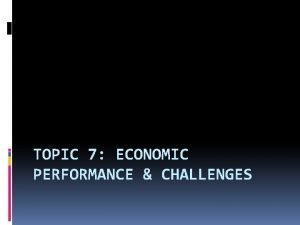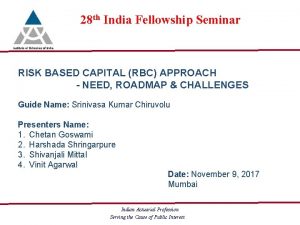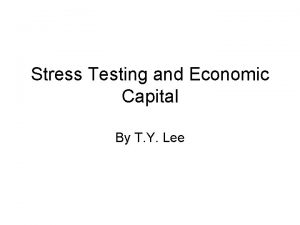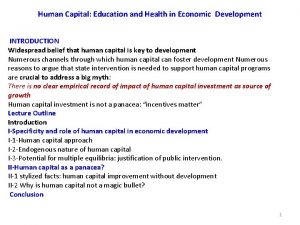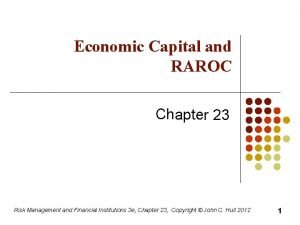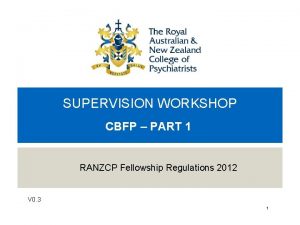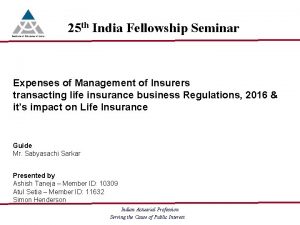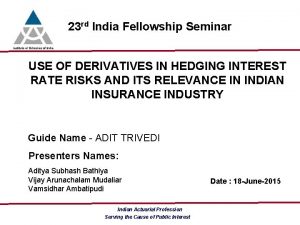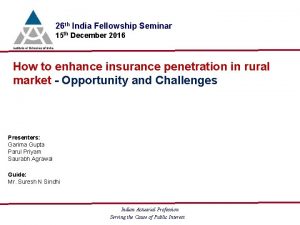28 th India Fellowship Seminar Topic Economic Capital



























- Slides: 27

28 th India Fellowship Seminar Topic: Economic Capital Pricing A concept, need and the way it differs from conventional pricing Guide Name: Udbhav Gupta Presenters Names: 1. Charul Kumar 2. Radhika Sen 3. Saigeeta Bhargava Indian Actuarial Profession Serving the Cause of Public Interest Date: 10 th November 2017 Mumbai

Agenda Context Introduction to Economic Capital Pricing Need for Economic Capital Pricing Challenges & Industry Considerations Closing Remarks www. actuariesindia. org 2

Current Solvency Requirement Looking at Pricing with Risk Lens Capital Backdrop Setting the context Economic Capital Risk Based Capital • • • ALSM Regulations, 2016 Factor Based IRDAI requirement to report since 2010 Being reported however not extensively used Committee has provided roadmap for adoption of RBC • In line with global trend Statutory Framework Economic Framework Company A Company B Backed by G Sec Backed by Equity Statutory Capital Economic Capital www. actuariesindia. org 3

Introduction to Economic Capital www. actuariesindia. org 4

Economic Capital Definition • The amount of capital that the insurer needs to ensure that its realistic balance sheet stays solvent over a certain time period with a pre-specified probability • For the purpose of this discussion we have taken Solvency II framework as basis of realistic balance sheet Expected Loss Frequency of Loss Economic Capital Extreme Losses Confidence Interval The confidence level depends on the risk appetite defined by the management Potential Loss www. actuariesindia. org 5

Economic Capital (contd. ) Risks Covered Insurance - Life Mortality Lapse/ Surrender Insurance - Non Life Risk Modules Market Credit Morbidity Interest Spread Catastrophe Equity Default Expense Liquidity Property Currency www. actuariesindia. org Operational EC is calculated at an individual risk level and generally combined through a correlation matrix to allow for the benefit of diversification 6

Economic Capital Pricing www. actuariesindia. org 7

Best Estimate Liability The Best Estimate Liability (BEL) is the present value of the Best Estimate Net Cashflows, discounted at a risk free rate. Note • • All assumptions are best estimate, with no margins for prudence Cash-flow projections are done on a policy by policy basis BEL can be negative i. e. no floor of ‘zero’ Allows for expected decrements & policyholder behavior (e. g. lapses) as well as the cost of financial options & guarantees www. actuariesindia. org 8

Risk Margin represents theoretical compensation for the risk of future experience being worse than the best estimate assumptions and for holding capital against this Methodology • It is based on the cost of holding capital to support those risks that cannot be hedged “Risks that cannot be hedged”? • Risks where the liabilities cannot be matched and replicated by any available traded financial instrument • E. g. • Risk of mortality/lapse experience being worse than the best estimate • Whole-of-life liabilities that are payable after 50+ years www. actuariesindia. org 9

Regulatory vs. Economic Balance Sheet • “Market driven” valuation of assets and liabilities • Discount Rate – IRDAI circular on EC highlight using risk free rate Economic Basis Traditional Basis Market Value Adjustment Own Funds Free Surplus RSM Value of Assets Prudential Margins Statutory Reserve www. actuariesindia. org Free Surplus Economic Capital Risk Margin Technical Provisions Market Value of Assets Best Estimate Liability (BEL) 10

How does all of this fit into ‘Pricing’? www. actuariesindia. org 11

Traditional Pricing Journey Product Design Targets Pricing • Concept • Set financial targets to be achieved at a portfolio level • Set premiums/benefits targeting the desired metric Profitability Monitoring • Regular Evaluation on updated assumptions Market Benchmarking • Distribution feedback mechanisms • Consumer Appeal • Exhaustive testing on portfolio projection • Sensitivity & Scenario Testing • Summary Financials for Management review Filing Regulatory Approval--> Launch www. actuariesindia. org 12

Traditional Pricing Journey Product Design Targets Pricing • Concept • Set financial targets to be achieved at a portfolio level • Set premiums/benefits targeting the desired metrics Profitability Monitoring • Regular Evaluation on updated assumptions Market Benchmarking • Distribution feedback mechanisms • Consumer Appeal • Exhaustive testing on portfolio projection • Sensitivity & Scenario Testing • Summary Financials for Management review Filing Regulatory Approval--> Launch www. actuariesindia. org 13

Approach At a model point level… Base BEL Determine the BEL using the existing best-estimate cashflows in the model Economic Capital Calculate Economic Capital requirement at each duration allowing for diversification of separate risks Co. C Risk Margin at t=0 Calculate the cost of holding capital at each duration Determine the Risk Margin as the present value of Co. C at t=0 discounted using the risk-free yield curve In this approach we represent the MVL as Market Value of Liability = BEL + Risk Margin (Technical Provisions) www. actuariesindia. org 14

Key Considerations Approach • Given the iterative pricing process, techniques should be appropriately simplified • Look to implement the approach on existing models and cashflows to maintain consistency • Set internal Economic Financial benchmarks in addition to desired Traditional financials • Monitoring frequency? Outcome • Need to be conscious of the consistency with existing products and customers • Need to assess product attractiveness vis-a-vis current industry practice Economic Capital based metrics shall serve to supplement existing financial reports providing additional information on product risks www. actuariesindia. org 15

Economic vs. Traditional Approach Traditional Pricing Economic Capital Pricing • RDR used to allow for product risks and Cost of Capital • Explicit allowance for product risks and Cost of Capital • Pricing Interest Rate basis expected fund/asset performance • Investment Return assumption is the Risk Free Rate • No diversification benefit of risks • Explicit Allowance for diversification of risks • Modelled to include Regulatory Capital • Capital basis risk assessment held • No understanding of the confidence interval underlying capital • Explicitly allows for choice of acceptable confidence interval www. actuariesindia. org 16

How could EC based Pricing impact the journey? www. actuariesindia. org 17

Pricing Journey Product Design Targets Pricing • Risk/Return? • Capital Efficiency? • Portfolio level Targets on an Economic Basis? • Set premiums/ benefits targeting desired EC based portfolio metric? Profitability Monitoring • Regular Testing on both Traditional and EC Basis • Risk assessment and check against repricing triggers Market Benchmarking • Exhaustive testing on both Traditional & EC Basis • Sensitivity & Scenario Testing • Comprehensive Pricing Report for Management review Filing Regulatory Approval--> Launch www. actuariesindia. org 18

Economic Measures www. actuariesindia. org 19

What can we measure? Economic Profit • Represents the Risk Adjusted Profit at t=0 by debiting the Risk Margin from the Gross Profit (at point of sale) • Economic Profit = (Gross Profit – Risk Margin) x (1 -tax) Economic Value Add (EVA) • Represents the absolute shareholder value that has been created by adjusting the Shareholder’s funds to reflect the cost of holding economic capital • EVA = ∆ Own Funds – Cost of Capital % x EC www. actuariesindia. org 20

Economic Metrics The Economic Profit & Economic Value Add (EVA) can then be used to generate suitable metrics at a model point level as well as a level with a realistic business mix projection. For e. g. : Economic VNB Margin% Economic Value Creation% www. actuariesindia. org • EVA as a %Premium • EVA as a %Capital 21

Need and Challenges of EC pricing www. actuariesindia. org 22

Need for Economic Capital Pricing Regulatory Capital varies by jurisdiction/ countries and for large groups difficult to ensure consistency in pricing strategy Helps in getting comparison with other line of business e. g. banking products Helps to identify efficient product strategy to deploy capital to new business. All product related business risks are measured and priced accurately. Highlights which risks are most onerous and if adequate mitigation is in place. Helps remove personal judgment from subjective assumptions Allows for diversification benefit www. actuariesindia. org 23

Challenges & Industry Considerations 1. Statutory requirement of capital • • How to integrate statutory capital requirement with EC pricing framework What target ROI should be considered in economic world vs statutory world Level of shareholder and management understanding How to ensure consistency with Peers 2. Risk free rate • Derivation of RFR – swap curve or government security • Consideration for any adjustment - Liquidity Premium to reflect inherent certainty. 3. Market consistent calculation of liability • Market not deep enough to calibrate market value of liabilities 4. Product Profitability • Some products will be less profitable and some will be more profitable on economic basis as a result the product mix may get impacted 5. Cost of Capital • Subjectivity on what factor to use www. actuariesindia. org 24

Challenges & Industry Considerations 6. Data • Insufficient data makes calibration of stresses and correlation factors difficult. Other regime e. g. SII prescribed factors are not calibrated with the Indian market • Some risks eg operational risk have scarce data 7. Level of Complexity • In line with number of iterations underlying pricing needs to be simple, Stochastic vs Deterministic 8. Penetration of smaller player • Larger player - Co. C is lower -> reducing pricing 9. Guidance on EC Pricing • Few steps have been taken to build understanding of EC pricing and EC integration into business activities. Further guidance can ensure consistency and drive understanding 10. Relevance • Post RBC www. actuariesindia. org 25

• Impact on product design & strategy. • Step towards readiness a parallel EC pricing can assist in understanding the implications of moving to economic framework www. actuariesindia. org Risk Consideration IRDAI Roadmap to move to RBC Closing Remarks • Risk is inherent to insurance and pricing it appropriately is the basis for policy holder and shareholder interest. • RBC committee report also points out that ‘companies to make use of Risk assessment of EC for day-to-day running of their business’. *IRDAI’s RBC Committee Report, 2017 26

Thank You! www. actuariesindia. org 27
 Basle ii
Basle ii Regulatory capital vs economic capital
Regulatory capital vs economic capital Contemporary india and education
Contemporary india and education Paragraph writing strategies
Paragraph writing strategies Topic down
Topic down Topic 7 economic performance and challenges
Topic 7 economic performance and challenges Free enterprise and other economic systems
Free enterprise and other economic systems Structure of capital market in india
Structure of capital market in india Bangalorebased capital india 50m series lightrock
Bangalorebased capital india 50m series lightrock Economic growth vs economic development
Economic growth vs economic development Prof. meier and baldwin
Prof. meier and baldwin Economics unit 1 lesson 2 difficult choices
Economics unit 1 lesson 2 difficult choices Economic capital
Economic capital Human capital education and health in economic development
Human capital education and health in economic development Market risk economic capital
Market risk economic capital What is economic capital
What is economic capital Gross operating cycle
Gross operating cycle Source of capital reserve
Source of capital reserve Multinational capital structure
Multinational capital structure Difference between capital reserve and reserve capital
Difference between capital reserve and reserve capital Constant vs variable capital
Constant vs variable capital Multinational cost of capital and capital structure
Multinational cost of capital and capital structure Capital allocation line vs capital market line
Capital allocation line vs capital market line Suffer not the xenos to live
Suffer not the xenos to live Dame kathleen ollerenshaw fellowship
Dame kathleen ollerenshaw fellowship Unc hematology and oncology
Unc hematology and oncology Ranzcp wba
Ranzcp wba Ernest mario
Ernest mario





